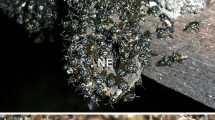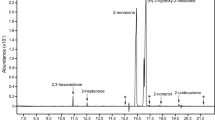Abstract
At the onset of mating flights inSolenopsis invicta, workers swarm excitedly over the mound as alates prepare to fly. Previous studies demonstrated that this excitement is stimulated by the male and female alates. We investigated the glandular source(s) of pheromones produced by the alates that cause excitement. The only common female and male alate body part that elicited excitement when crushed was the head. Within the head, excised mandibular glands were found to be responsible for worker excitement. Fire ant workers are very sensitive to external stimuli and some excitement was elicited by crushed female gasters and male thoraces, but the response was never as significant as with crushed heads. Tests with summer and winter alates revealed similar results, except that gasters of winter female alates had a greater excitant effect than did gasters of summer female alates. This may be due to the production of attractant pheromones by the poison glands of overwintering female alates. We conclude that the mandibular gland is the source of alate excitant pheromones.
Similar content being viewed by others
References
Attygalle, A. B., and Morgan, E. D. (1985). Ant trial pheromones.Adv. Insect Physiol. 18: 1–30.
Bass, J. A., and Hays, S. B. (1979). Nuptial flights of the imported fire ant in South Carolina.J. Ga. Entomol. Soc. 14: 158–161.
Billen, J. (1990). A survey of the glandular system of fire ants. In Vander Meer, R. K., Jaffe, K., and Cedeno, A. (eds.),Applied Myrmecology, a World Perspective, Westview Press, Boulder, CO, pp. 85–94.
Blum, M. S. (1969). Alarm pheromones.Annu. Rev. Entomol. 14: 57–80.
Blum, M. S. (1980). Pheromones of adult fire ants. Proc. Tall Timbers.Conf. Ecol. Anim. Control Habitat Manage. 7: 55–60.
Blum, M. S. (1985). Alarm pheromones. In Kerkut, G. A., and Gilbert, L. I. (eds.),Comprehensive Insect Physiology, Biochemistry, and Pharmacology, Vol. 9. Behaviour, Pergamon Press, New York, pp. 193–224.
Blum, M. S., and Amante, E. (1981).o-Aminoacetophenone: Identification in a primitive fungus-growing ant (Mycocepurus goeldii).Experientia 37: 816–817.
Blum, M. S., Padovani, F., Hermann, H. R., and Kannowski, P. B. (1968). Chemical releasers of social behavior. XI. Terpenes in the mandibular glands ofLasius umbratus.Ann. Entomol. Soc. Am. 61: 1354–1359.
Blum, M. S., Snelling, R. R., Duffield, R. M., Hermann, H. R., Jr., and Lloyd, H. A. (1988). Mandibular gland chemistry ofCamponotus (Myrmothrix) abdominalis: Chemistry and chemosystematic implications (Hymenoptera: Formicidae). In Trager, J. C. (ed.),Advances in Myrmecology, E. J. Brill, Leiden, pp. 481–490.
Bradshaw, J. W. S., Baker, R., and Howse, P. E. (1975). Multicomponent alarm pheromones of the weaver ant.Nature 258: 230–231.
Bradshaw, J. W. S., Baker, R., and Howse, P. E. (1979). Multicomponent alarm pheromones in the mandibular glands of major workers of the African weaver ant,Oecophylla longinoda.Physiol. Entomol. 4: 15–25.
Brand, J. M., Duffield, R. M., MacConnell, J. G., and Blum, M. S. (1973). Caste-specific compounds in male carpenter ants.Science 179: 388–389.
Buschinger, A., and Alloway, T. M. (1979). Sexual behaviour in the slave-making ant,Harpagoxenus canadensis M. R. Smith, and sexual pheromone experiments withHarpagoxenus canadensis, Harpagoxenus americanus (Emery), andHarpagoxenus sublaevis (Nylander) (Hymenoptera: Formicidae).Z. Tierpsychol. 49: 113–119.
Buschinger, A., and Maschwitz, U. (1984). Defensive behavior and defensive mechanisms in ants. In Hermann, H. R. (ed.),Defensive Mechanisms in Social Insects, Praeger Scientific, New York, pp. 95–141.
Cammaerts, M. C., Inwood, M. R., Morgan, E. D., Parry, K., and Tyler, R. C. (1978). Comparative study of the pheromones emitted by workers of the antsMyrmica rubra andMyrmica scabrinodis.J. Insect Physiol. 24: 207–214.
Cammaerts, M. C., Evershed, R. P., and Morgan, E. D. (1983). The volatile components of the mandibular gland secretion of workers of the antsMyrmica lobicornis andMyrmica sulcinodis.J. Insect Physiol. 29: 659–664.
Cammaerts, M. C., Attygalle, A. B., Evershed, R. P., and Morgan, E. D. (1985). The pheromonal activity of chiral 3-octanol forMyrmica ants.Physiol. Entomol. 10: 33–36.
Cammaerts-Tricot, M. C. (1973). Pheromones agregeant les ouvrieres deMyrmica rubra.J. Insect Physiol. 19: 1299–1315.
Do Nascimiento, R. R., Morgan, E. D., Billen, J., Schoeters, E., Della Lucia, T. M. C., and Bento, J. M. S. (1993). Variation with caste of the mandibular gland secretion in the leaf-cutting antAtta sexdens rubropilosa.J. Chem. Ecol. 19: 907–918.
Duffield, R. M., and Blum, M. S. (1975). Identification, role, and systematic significance of 3-octanone in the carpenter ant,Camponotus schaefferi Whr.Comp. Biochem. Physiol. 51B: 281–282.
Duffield, R. M., Brand, J. M., and Blum, M. S. (1977). 6-Methyl-5-hepten-2-one inFormica species: Identification and function as an alarm pheromone (Hymenoptera: Formicidae).Ann. Entomol. Soc. Am. 70: 309–310.
Duffield, R. M., Wheeler, J. W., and Blum, M. S. (1980). Methyl anthranilate: Identification and possible function inAphaenogaster fulva andXenomyrmex floridanus.Fla. Entomol. 63: 203–206.
Fletcher, D. J. C., and Blum, M. C. (1983). The inhibitory pheromone of queen fire ants: Effects of disinhibition on dealation and oviposition by virgin queens.J. Comp. Physiol. 153: 467–475.
Fowler, H. G. (1982). Male induction and function of workers’ excitability during swarming in leaf-cutting ants (Atta andAcromyrmex) (Hymenoptera, Formicidae) pheromones.Int. J. Invertebr. Reprod. 4: 333–335.
Green, H. B. (1952). Biology and control of the imported fire ant in Mississippi.J. Econ. Entomol. 45: 593–597.
Glancey, B. M., Glover, A., and Lofgren, C. S. (1981). Pheromone production by virgin queens ofSolenopsis invicta Buren.Sociobiology 6: 119–127.
Hölldobler, B. (1971). Sex pheromone in the antXenomyrmex floridanus.J. Insect Physiol. 17: 1497–1499.
Hölldobler, B. (1976). The behavioral ecology of mating in harvester ants (Hymenoptera: Formicidae: Pogonomyrmex).Behav. Ecol. Sociobiol. 1: 405–423.
Hölldobler, B. (1995). The chemistry of social regulation: Multicomponent signals in ant societies.Proc. Natl. Acad. Sci. USA 92: 19–22.
Hölldobler, B., and Haskins, C. P. (1977). Sexual calling behavior in primitive ants.Science 195: 793–794.
Hölldobler, B., and Wilson, E. O. (1970). Recruitment trails in the harvester antPogonomyrmex badius.Psyche 77: 385–399.
Hölldobler, B., and Wilson, E. O. (1990).The Ants, Belknap Press, Cambridge, MA.
Hölldobler, B., Palmer, J. M., and Moffett, M. W. (1990). Chemical communication in the dacetine antDaceton armigerum (Hymenoptera: Formicidae).J. Chem. Ecol. 16: 1207–1219.
Jouvenaz, D. P., Banks, W. A., and Lofgren, C. S. (1974). Fire ants: Attraction of workers to queen secretions.Ann. Entomol. Soc. Am. 67: 442–444.
Kugler, C. (1979). Alarm and defense: A function for the pygidial gland of the myrmicine ant,Pheidole biconstricta, in coffee plantations in the foothills of the Sierra Nevada de Santa Marta in northern Colombia.Ann. Entomol. Soc. Am. 72: 532–536.
Law, J. H., Wilson, E. O., and McCloskey, J. A. (1965). Biochemical polymorphism in ants.Science 149: 544–546.
Lloyd, H. A., Blum, M. S., and Duffield, R. M. (1975). Chemistry of the male mandibular gland secretion of the ant,Camponotus clarithorax.Insect Biochem. 5: 489–494.
Markin, G. P., Dillier, J. H., Hill, S. O., Blum, M. S., and Hermann, H. R. (1971). Nuptial flight and flight ranges of the imported fire ant,Solenopsis saevissima richteri (Hymenoptera: Formicidae).J. Ga. Entomol. Soc. 6: 145–156.
Markin, G. P., O’Neal, J., and Dillier, J. (1975). Foraging tunnels of the red imported fire ant,Solenopsis invicta.J. Kans. Entomol. Soc. 48: 82–88.
Milio, J., Lofgren, C. S., and Williams, D. F. (1988). Nuptial flight studies of field-collected colonies ofSolenopsis invicta Buren. In Trager, J. C. (ed.),Advances in Myrmecology, E. J. Brill, New York, pp. 419–431.
Morrill, W. L. (1974). Production and flight of alate red imported fire ants.Environ. Entomol. 3: 265–271.
Obin, M. S., and Vander Meer, R. K. (1994). Alate semiochemicals release worker behavior during fire ant nuptial flights.J. Entomol. Sci. 29: 143–151.
Olubajo, O., Duffield, R. M., and Wheeler, J. W. (1980). 4-Heptanone in the mandibular gland secretion of the Nearctic ant,Zacryptocerus varians (Hymenoptera: Formicidae).Ann. Entomol. Soc. Am. 73: 93–94.
Parry, K., and Morgan, E. D. (1979). Pheromones of ants: A review.Physiol. Entomol. 4: 161–189.
Pasteels, J. M., Verhaeghe, J. C., Braekman, J. C., Daloze, D., and Tursch, B. (1980). Caste-dependent pheromones in the head of the antTetramorium caespitum.J. Chem. Ecol. 6: 467–472.
Phillips, S. A., Jr., and Vinson, S. B. (1980). Comparative morphology of glands associated with the head among castes of the red imported fire ant,Solenopsis invicta Buren.J. Ga. Entomol. Soc. 15: 215–226.
Rhoades, W. C., and Davis, D. R. (1967). Effects of meteorological factors on the biology and control of the imported fire ant.J. Econ. Entomol. 60: 554–558.
Robertson, P. L. (1971). Pheromones involved in aggressive behaviour in the ant,Myrmecia gulosa.J. Insect Physiol. 17: 691–715.
Sokal, R. R., and Rohlf, F. J. (1981).Biometry, W. H. Freeman, New York.
Tomalski, M. D., Blum, M. S., Jones, T. H., Fales, H. M., Howard, D. F., and Passera, L. (1987). Chemistry and functions of exocrine secretions of the antsTapinoma melanocephalum andT. erraticum.J. Chem. Ecol. 13: 253–263.
Tricot, M.-C., Pasteels, J. M., and Tursch, B. (1972). Phéromones stimulant et inhibant l’agressivité chezMyrmica rubra.J. Insect Physiol. 18: 499–509.
Vander Meer, R. K., Glancey, B. M., Lofgren, C. S., Glover, A., Tumlinson, J. H., and Rocca, J. (1980). The poison sac of red imported fire ant queens: Source of a pheromone attractant.Ann. Entomol. Soc. Am. 73: 609–612.
Vander Meer, R. K., Alvarez, F., and Lofgren, C. S. (1988). Isolation of the trial recruitment pheromone ofSolenopsis invicta.J. Chem. Ecol. 14: 825–838.
Wheeler, J. W., Evans, S. L., Blum, M. S., and Torgerson, R. L. (1975). Cyclopentyl ketones: Identification and function inAzteca ants.Science 187: 254–255.
Wilson, E. O. (1958). A chemical releaser of alarm and digging behavior in the antPogonomyrmex badius (Latreille).Psyche 65: 41–51.
Wilson, E. O. (1962). Chemical communication among workers of the fire antSolenopsis saevissima (Fr. Smith). 3. The experimental induction of social responses.Anim. Behav. 10: 159–164.
Wilson, E. O., and Bossert, W. H. (1963). Chemical communication among animals.Recent Prog. Hormone Res. 19: 673–716.
Wilson, E. O., and Regnier, F. E., Jr. (1971). The evolution of the alarm-defense system in the formicine ants.Am. Nat. 105: 279–289.
Author information
Authors and Affiliations
Rights and permissions
About this article
Cite this article
Alonso, L.E., Vander Meer, R.K. Source of alate excitant pheromones in the red imported fire antSolenopsis invicta (Hymenoptera: Formicidae). J Insect Behav 10, 541–555 (1997). https://doi.org/10.1007/BF02765376
Issue Date:
DOI: https://doi.org/10.1007/BF02765376




